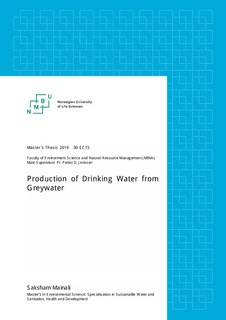Production of drinking water from greywater
Master thesis
Submitted version
Permanent lenke
http://hdl.handle.net/11250/2629492Utgivelsesdato
2019Metadata
Vis full innførselSamlinger
- Master’s theses (MINA) [668]
Sammendrag
Potable water is becoming an increasingly scarce in parts of the world due to population increase and the effects of climate change. Reuse of wastewater as alternative source for nonpotable use has been advocated and researched in the last decades to curb water scarcity problem. The NEWater project in Singapore, however, demonstrated the advances in treatment technology to treat wastewater to a level of drinking water quality with great success. Sourceseparated greywater (water from showers, washing and kitchen) constitutes 60-90% of the total volume of wastewater. Greywater has lower nutrient content and less pathogens than the combined wastewater (wastewater including Blackwater or toilet waste), hence, it should be easier to treat and recycle. This study was initiated to contribute to the SiEUGreen project. One of the goals of SiEUGreen project is to demonstrate and realize about 90% reduction in total water consumption through improved water use efficiencies and on-site treatment and recycling and reusing of the greywater stream of the domestic wastewater. The main objective of this thesis is, therefore, to study the combined treatment efficiency of constructed wetland as pre-treatment step and activated carbon and nano filtration of the effluent as post treatment source-separated greywater to achieve a drinking water quality standard. For this purpose a constructed wetland treated greywater effluent was taken from Nesodden and the efficiency of nano filtration (using Nerox 0.2 nm pore filter) alone or in combination with granular activated carbon was tested. The laboratory analysis results showed that the effluent from the constructed wetland had E. coli below the detection limit, whereas the total coliform bacteria was 226 MPN/100 ml indicating high treatment performance. Moreover, total COD, turbidity, total nitrogen (tot N), ammonium, pH and phosphate for this effluent were 22 mg/l, 4.55 NTU, 7.65 mg/l, 6.218 mg/l, 7.96, and <0,1 mg/l, respectively. Nano filter in combination with activated carbon column filtration in different sequences further improved the quality of the effluent to a drinking water quality except the ammonium concentration which exceeded the WHO and Norwegian drinking water quality guidelines. Greywater may contain organic micro pollutants like pharmaceuticals and personal care products (PPCPs). Examination of PPCPs was not included in this study and further investigation on the removal efficiencies of the above mentioned treatment systems on PPCPs is necessary to satisfy the use of treated greywater as alternative drinking water source.

